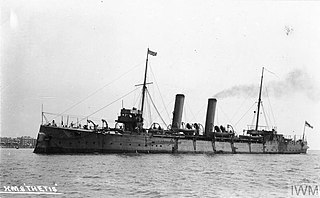
HMS Thetis was an Apollo-class 2nd class protected cruiser of the Royal Navy, launched on 13 December 1890. Her first significant mission was service in the Bering Sea Patrol with American warships in a combined effort to suppress poaching in the Bering Sea.

HMS Andromache was an Apollo-class protected cruiser of the Royal Navy. William Henry White designed her, and she was built at Chatham Dockyard and launched on 14 August 1890. The total cost of construction was £186,234.
HMS Sprightly was a B-class torpedo boat destroyer of the British Royal Navy. She was built speculatively by Laird, Son & Company, Birkenhead, pre-empting further orders for vessels of this type, and was purchased by the navy in 1901.

HMS Edgar was a first class cruiser of the Royal Navy, and lead ship of the Edgar class. She was built at Devonport and launched on 24 November 1890. She served on the China Station, and in the First World War in the Gallipoli Campaign, along with her sisters Endymion, Grafton and Theseus.
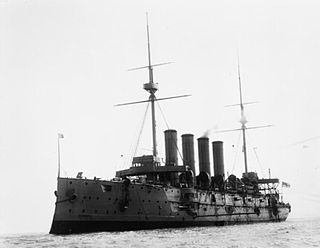
HMS Diadem was the lead ship of the Diadem-class of protected cruiser in the Royal Navy.

HMS Amphitrite was a ship of the Diadem-class of protected cruisers in the Royal Navy, which served in the First World War.

HMS Ariadne was a Diadem-class protected cruiser of the Royal Navy, which was launched in 1898, In March 1913, she was converted to a stokers' training ship and in 1917 was converted to a minelayer and assigned to the Nore Command. She was torpedoed and sunk off Beachy Head by the German submarine UC-65 on 26 July 1917.

HMS Europa was a ship of the Diadem-class protected cruisers in the Royal Navy. She was built by J&G Thompson of Clydebank and launched on 20 March 1897.

HMS Blake, named in honour of Admiral Robert Blake, was the lead ship of her class of protected cruiser that served in the Royal Navy from 1889 to 1922.
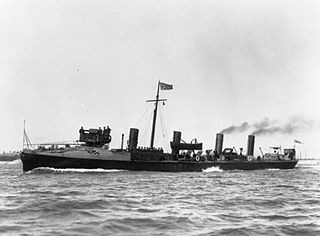
HMS Ferret was a Ferret-class destroyer which served with the Royal Navy from 1893 and was sunk in 1911.
Five ships of the Royal Navy have borne the name HMS Flora:

HMS Dryad was the name ship of the Dryad-class torpedo gunboats. She was launched at Chatham Dockyard on 22 November 1893, the first of the class to be completed. She served as a minesweeper during World War I and was broken up in 1920.

HMS Spartan was an Apollo-class cruiser of the Royal Navy constructed in 1891. The design was a variant of the Marathon-class cruiser. The ships had quick firing guns which were effective as a broadside, but less so when attempting to fire fore or aft.

HMS Astraea was an Astraea-class second class cruiser of the Royal Navy. She was built towards the end of the nineteenth century, and survived to serve in the First World War.
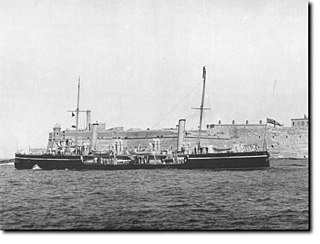
The sixth HMS Harrier was a Dryad-class torpedo gunboat. She was launched at Devonport Dockyard on 20 February 1894, and saw service in the Mediterranean and in fishery protection. She served as a minesweeper during World War I and was sold for commercial use in 1920.

The Astraea class was an eight ship class of protected cruisers built for the Royal Navy during the 1890s. The ships served on a number of foreign stations during their careers, particularly in the waters of the Indian and Pacific Oceans, and around the Cape of Good Hope. Already obsolete by the outbreak of the First World War, most continued to see service in a variety of roles, though rarely in a front line capacity. By the end of the war the majority were being used as training or depot ships, and they were soon sold out of the service and scrapped. However, one ship, HMS Hermione, was bought by the Marine Society and used as a training ship until 1940.

HMS Icarus was a Mariner-class composite screw gunvessel of 8 guns, and the third Royal Navy vessel to carry the name. She was launched in 1885 at Devonport and sold in 1904.
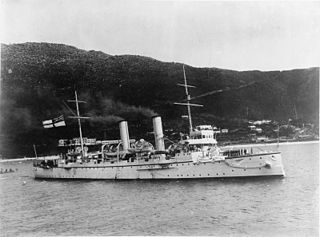
HMS Forte was an Astraea-class cruiser of the Royal Navy launched on 9 December 1893. She was constructed under the Naval Defence Act of 1889 along with several other Astraea-class cruisers. Forte was eventually decommissioned in 1913.
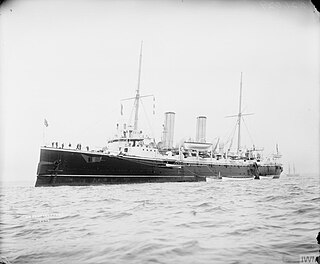
HMS Bonaventure was an Astraea-class second class cruiser of the Royal Navy, ordered as part of the eight-ship Astraea class under the Naval Defence Act of 1889. She was commissioned for service in 1895, and survived to serve in the First World War.

HMS Naiad was an Apollo-class protected cruiser of the Royal Navy which served from 1892 to 1919.




















